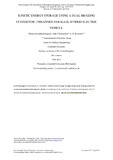- CERES Home
- →
- Cranfield Defence and Security
- →
- Staff publications (CDS)
- →
- View Item
JavaScript is disabled for your browser. Some features of this site may not work without it.
| dc.contributor.author | Suntharalingam, P. | |
| dc.contributor.author | Economou, John T. | |
| dc.contributor.author | Knowles, Kevin | |
| dc.date.accessioned | 2016-11-28T14:55:25Z | |
| dc.date.available | 2016-11-28T14:55:25Z | |
| dc.date.issued | 2016-11-06 | |
| dc.identifier.citation | Suntharalingam P, Economou JT, Knowles K. (2016) Kinetic energy storage using a dual braking system for unmanned parallel hybrid electric vehicle. Proceedings of the Institution of Mechanical Engineers, Part D: Journal of Automobile Engineering, Volume 231, Issue 10, 2017, pp.1353-1373 | en_UK |
| dc.identifier.uri | https://doi.org/10.1177/0954407016672591 | |
| dc.identifier.uri | http://dspace.lib.cranfield.ac.uk/handle/1826/11041 | |
| dc.description.abstract | In this paper a novel regenerative dual braking strategy is proposed for utility/goods delivery unmanned vehicles in public roads, which improves the regenerative energy capturing ability and consequently improves the fuel use of parallel hybrid power train configurations for land unmanned vehicles where the priority is not comfort but extending the range. Furthermore, the analysis takes into account the power handling ability of the electric motor and the power converters. In previous research a plethora of regenerative braking strategies is shown, for this paper the key contribution is that the vehicle electric regeneration is related to a fixed braking distance in relation to the energy storage capabilities specifically for unmanned utility type land vehicles where passenger comfort is not a concern but pedestrian safety is of critical importance. Furthermore, the vehicle’s power converter capabilities facilitate the process of extending the braking time via introducing a variable deceleration profile. The proposed approach has therefore resulted in a regenerative algorithm which improves the vehicle’s energy storage capability without considering comfort since this analysis is applicable to unmanned vehicles. The algorithm considers the distance as the key parameter, which is associated to safety, therefore it allows the braking time period to be extended thus favouring the electric motor generation process while sustaining safety. This method allows the vehicle to brake for longer periods rather than short bursts hence resulting in a more effective regeneration with reduced use of the dual (i.e. caliper/stepper motor brake system). The regeneration method and analysis is addressed in the following paper sections. The simulation results show that the proposed regenerative braking strategy has improved significantly the energy recapturing ability of the hybrid power train configuration. The paper is also supported with experimental data that verify the theoretical development and the simulation results. The two strategies developed and implemented are Constant Braking Torque (CBT) and Constant Braking Power (CBP). Both methods were limited to a fixed safety-based distance. Overall the results demonstrate that the CBT method results in better energy-based savings. | en_UK |
| dc.publisher | Sage / IMECHE | en_UK |
| dc.rights | Attribution-NonCommercial 4.0 International | |
| dc.rights.uri | http://creativecommons.org/licenses/by-nc/4.0/ | |
| dc.title | Kinetic energy storage using a dual braking system for unmanned parallel hybrid electric vehicle | en_UK |
| dc.type | Article | en_UK |
| dc.identifier.cris | 15283502 |
Files in this item
This item appears in the following Collection(s)
-
Staff publications (CDS) [1209]

